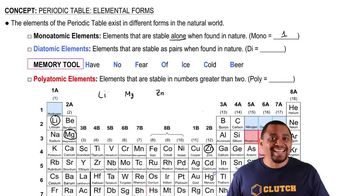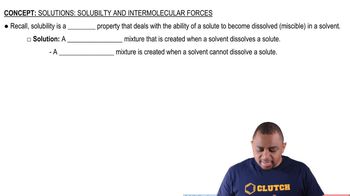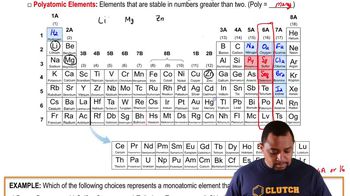Which of the following figures represents (a) a pure element, (More than one picture might fit each description.)
Ch.1 - Introduction: Matter, Energy, and Measurement
Chapter 1, Problem 2b
Which of the following figures represents (b) a mixture of two elements, (More than one picture might fit each description.)
 Verified step by step guidance
Verified step by step guidance1
Step 1: Understand the definition of a mixture of two elements. A mixture consists of two or more substances that are physically combined, not chemically bonded. In this case, the mixture contains two different elements, each represented by distinct types of atoms or symbols.
Step 2: Identify the figures that show two different types of atoms or symbols coexisting without forming compounds. Look for images where two distinct elements are present but not chemically combined (no bonds or compound structures).
Step 3: Exclude figures that show only one type of atom (which would be a pure element) or figures where atoms are chemically bonded to form compounds (which would not be a mixture but a compound).
Step 4: Select all figures that display two different elements physically mixed together, such as separate clusters or individual atoms of each element, without any indication of chemical bonding.
Step 5: Confirm your selection by verifying that the chosen figures meet the criteria of a mixture of two elements: presence of two distinct elements and no chemical bonding between them.

Verified video answer for a similar problem:
This video solution was recommended by our tutors as helpful for the problem above.
Video duration:
2mWas this helpful?
Key Concepts
Here are the essential concepts you must grasp in order to answer the question correctly.
Elements and Their Representation
An element is a pure substance consisting of only one type of atom, represented by identical symbols or spheres in diagrams. Understanding how elements are depicted helps distinguish them from compounds or mixtures in visual models.
Recommended video:
Guided course

Elemental Forms of Elements
Mixtures vs. Compounds
A mixture contains two or more substances physically combined without chemical bonding, so the individual components retain their properties. In diagrams, mixtures show different types of atoms or molecules coexisting but not chemically bonded.
Recommended video:
Guided course

Solubility and Mixtures
Visual Identification of Mixtures of Elements
A mixture of two elements will show two distinct types of atoms (different symbols or colors) present together but not bonded into molecules. Recognizing this pattern in figures helps identify mixtures of elements as opposed to compounds or pure substances.
Recommended video:
Guided course

Chalcogen Identification Example
Related Practice
Textbook Question
433
views
Textbook Question
Which of the following figures represents (c) a pure compound, (More than one picture might fit each description.)
260
views
Textbook Question
Which of the following figures represents (d) a mixture of an element and a compound? (More than one picture might fit each description.)
661
views
Textbook Question
Musical instruments like trumpets and trombones are made from an alloy called brass. Brass is composed of copper and zinc atoms and appears homogeneous under an optical microscope. The approximate composition of most brass objects is a 2:1 ratio of copper to zinc atoms, but the exact ratio varies somewhat from one piece of brass to another. (a) Would you classify brass as an element, a compound, a homogeneous mixture, or a heterogeneous mixture?
126
views
1
rank
